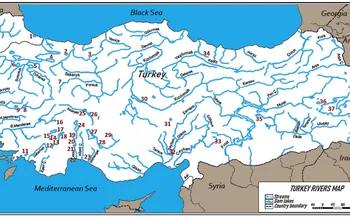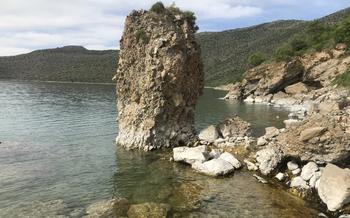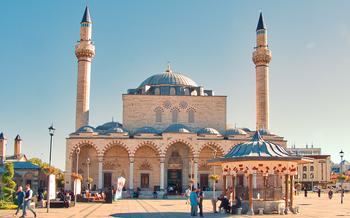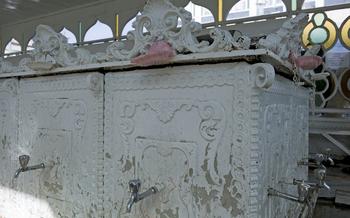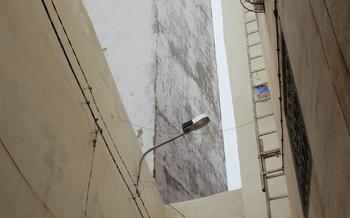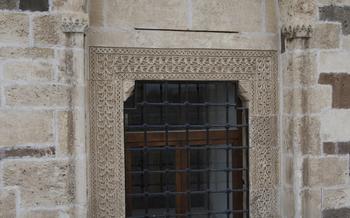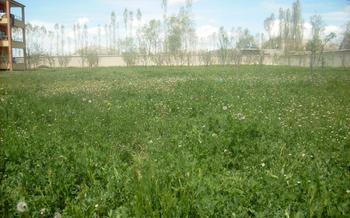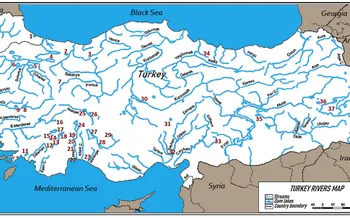
Tomb of İbrahim Kadi
- Van's Monumental Tomb
- Journey to the Past: Unveiling the History
- Exploring the Tomb's Architecture
- Cultural Significance: A Revered Landmark
- Paying Respects: Etiquette and Customs
- Capturing the Essence: Photography Tips
- Exploring the Surroundings: Unveiling Hidden Treasures
- Transportation: Getting There and Around
- Accommodation: Resting in Van
- Food and Drink: Culinary Delights
- Shopping: Local Treasures
- Safety Tips: Ensuring a Smooth Trip
- Budgeting: Planning Your Expenses
- Language and Communication
- Insider Tip: Unveiling a Hidden Gem
Van's Monumental Tomb
In the heart of Van, a city steeped in history and culture, stands a majestic monument that has captured the imagination of travelers and locals alike: the Tomb of İbrahim Kadi. This monumental tomb, dating back to the 16th century, serves as a testament to the rich architectural heritage of the region and holds immense historical and cultural significance.
With its intricate carvings, elegant calligraphy, and imposing presence, the Tomb of İbrahim Kadi is a masterpiece of Islamic architecture. The tomb's unique design and symbolism have made it a beloved landmark, attracting visitors from far and wide who come to marvel at its beauty and pay homage to the revered figure buried within.
Journey to the Past: Unveiling the History
The Tomb of İbrahim Kadi stands as a testament to the rich history of Van, a city that has witnessed the rise and fall of civilizations. Its origins date back to the 13th century, when the region was ruled by the Seljuk dynasty. The tomb was commissioned by İbrahim Kadi, a prominent religious figure and scholar who played a pivotal role in the spread of Islam throughout the region.
İbrahim Kadi was known for his piety and his dedication to the teachings of the Prophet Muhammad. He was a prolific writer and orator, and his works are still studied by scholars today. His influence extended beyond religious matters, as he was also a skilled administrator and diplomat. He played a key role in mediating between the Seljuk rulers and the local population, helping to maintain peace and stability in the region.
The tomb has been the site of numerous historical events over the centuries. It has been visited by pilgrims from all over the world, who come to pay their respects to İbrahim Kadi and to seek his blessings. The tomb has also been a gathering place for scholars and intellectuals, who have come to discuss religious, philosophical, and political issues.
Numerous legends and tales are associated with the tomb. One legend tells of a young woman who was unjustly accused of a crime and was sentenced to death. She prayed to İbrahim Kadi for his help, and he appeared to her in a dream, telling her that she would be saved. The next day, the woman was miraculously acquitted of all charges.
Another tale tells of a group of soldiers who were passing through Van and decided to camp near the tomb. During the night, they were attacked by a band of bandits. The soldiers fought bravely, but they were outnumbered and outmatched. Just when it seemed that all was lost, İbrahim Kadi appeared and led the soldiers to victory.
These legends and tales have helped to perpetuate the legacy of İbrahim Kadi and to make the tomb a place of reverence and awe.
Exploring the Tomb's Architecture
The Tomb of İbrahim Kadi stands as a testament to the architectural prowess of its time. Its unique design elements set it apart from other historical tombs in the region. The tomb's exterior is adorned with intricate carvings and inscriptions, showcasing the artistic talents of the era's master craftsmen. The interior, though simple in design, exudes an aura of serenity and reverence.
The construction of the tomb employed a combination of stone and brick, demonstrating the durability and resilience of the materials used. The tomb's dome, a striking feature, is supported by four massive pillars, creating a sense of grandeur and spaciousness within the chamber.
Symbolism and motifs are woven into the architecture of the tomb, adding layers of meaning to its structure. Geometric patterns, floral motifs, and calligraphic inscriptions adorn the walls, each holding a unique significance in Islamic art and culture.
Comparing the Tomb of İbrahim Kadi with other historical tombs in the region reveals its distinct characteristics. While sharing similarities in terms of their religious significance and architectural style, the tomb stands out for its intricate carvings, unique dome design, and the use of both stone and brick in its construction. These elements contribute to the tomb's status as a remarkable architectural gem in the region.
Cultural Significance: A Revered Landmark
The Tomb of İbrahim Kadi holds immense cultural significance, transcending its architectural grandeur. It serves as a sacred site for religious observances, attracting pilgrims and devotees from far and wide. The tomb has become deeply entwined with local traditions and customs, embodying the region's rich cultural heritage.
As a symbol of unity and shared history, the tomb fosters a sense of belonging and pride among the local community. Its enduring presence serves as a reminder of the region's rich past, connecting generations and preserving cultural identity.
Preservation and restoration efforts have been meticulously undertaken to safeguard the tomb's historical integrity and cultural significance. These endeavors reflect the deep reverence and appreciation held for this cherished landmark, ensuring its legacy endures for generations to come.
Paying Respects: Etiquette and Customs
When visiting the Tomb of İbrahim Kadi, it is essential to be mindful of local customs and etiquette to show respect for the religious and cultural significance of the site.
- Appropriate Dress Code:
- Dress modestly and conservatively, covering your shoulders and knees.
-
Avoid wearing revealing or overly casual attire.
-
Traditional Rituals and Ceremonies:
- If you witness a traditional ceremony or ritual, observe quietly and respectfully from a distance.
-
Do not interrupt or interfere with any ongoing religious practices.
-
Etiquette for Visitors:
- Be respectful of the tomb's sanctity and maintain a quiet and solemn demeanor.
- Avoid loud conversations, laughter, or any behavior that could be disruptive.
-
Refrain from touching or leaning against the tomb's structure or any sacred objects.
-
Respecting Local Customs and Beliefs:
- Remember that the tomb holds deep religious significance for many people.
- Be respectful of local customs and beliefs, even if they differ from your own.
- Ask questions and seek guidance from locals if you are unsure about any customs or practices.
Capturing the Essence: Photography Tips
The Tomb of İbrahim Kadi, with its intricate architecture and serene ambiance, offers a captivating subject for photography enthusiasts. To capture the essence of this historical gem, consider the following tips:
-
Best Angles and Lighting Conditions: The tomb's grandeur is best captured from a low angle, allowing you to accentuate its towering structure. For optimal lighting, visit during the golden hours of sunrise or sunset when the warm hues bathe the tomb in a magical glow.
-
Showcase the Tomb's Grandeur: Position yourself at a distance to capture the tomb's full majesty. Use wide-angle lenses to emphasize its scale and incorporate the surrounding landscape for a sense of place.
-
Avoid Common Photography Mistakes: Steer clear of shooting directly into the sun, which can lead to harsh shadows and overexposed areas. Additionally, avoid using a flash, as it can flatten the texture and depth of the tomb's intricate carvings.
-
Create Memorable Compositions: Experiment with different perspectives and compositions to create dynamic and visually appealing images. Incorporate elements of the surrounding landscape, such as trees, flowers, or the nearby mountains, to add depth and interest to your shots.
Exploring the Surroundings: Unveiling Hidden Treasures
Venturing beyond the captivating Tomb of İbrahim Kadi, travelers are greeted with an array of other captivating attractions that showcase Van's rich history and natural allure. A short stroll from the tomb lies the imposing Van Fortress, a testament to the city's ancient past. Perched atop a hill, the fortress offers breathtaking panoramic views of the city and Lake Van, the largest lake in Turkey. Explore its well-preserved ramparts, towers, and gates, and immerse yourself in the tales of battles and conquests that have unfolded within its walls.
For those seeking a tranquil escape, the serene shores of Lake Van beckon. Take a leisurely stroll along the picturesque lakeside promenade, marveling at the stunning views of the lake's shimmering turquoise waters. Indulge in a rejuvenating swim or embark on a boat tour to discover the lake's hidden coves and islands. The surrounding mountains provide a picturesque backdrop, inviting you to embark on invigorating hikes or mountain biking adventures.
Van is also home to vibrant local markets and bazaars, where you can delve into the city's vibrant commercial traditions. The Van Bazaar, located in the heart of the city, is a treasure trove of local handicrafts, textiles, and culinary delights. Experience the lively atmosphere as you barter with friendly vendors, seeking the best deals on unique souvenirs and trinkets. From intricately woven carpets to mouthwatering local delicacies, the Van Bazaar offers a sensory feast that will delight all visitors.
No exploration of Van is complete without savoring the city's delectable cuisine. Indulge in the flavors of traditional Turkish dishes, prepared with fresh local ingredients and infused with unique regional influences. Sample the succulent grilled meats, tantalizing kebabs, and aromatic stews that are the hallmarks of Turkish gastronomy. Don't miss the opportunity to try Van's signature dish, "Van kahvaltısı," a hearty breakfast spread that showcases the region's culinary prowess.
Transportation: Getting There and Around
Reaching Van and navigating its transportation system is a breeze. The city is well-connected by air, with Van Ferit Melen Airport (VAN) offering direct flights from major cities in Turkey and beyond. Upon arrival, you can conveniently hop on the airport shuttle or hail a taxi to reach your accommodation or the city center.
For those seeking flexibility and independence, renting a car is an excellent option. Several car rental agencies are available at the airport and in the city, offering a wide range of vehicles to suit your needs and budget. Remember to carry your international driving permit if you're planning to drive in Turkey.
If you prefer a more local experience, the public transportation system in Van is efficient and affordable. Buses and minibuses connect different parts of the city, and fares are incredibly reasonable. You can purchase a transportation card for even greater savings.
To explore the surrounding areas and venture beyond the city limits, consider hiring a guide. Local guides not only provide valuable insights into the region's history and culture but also arrange transportation, ensuring a hassle-free and enriching experience.
Accommodation: Resting in Van
Van offers a range of accommodation options to suit diverse preferences and budgets. From modern hotels to cozy guesthouses, travelers can find a place to rest and recharge after exploring the city's treasures.
For those seeking comfort and luxury, the city center boasts several reputable hotels with amenities like swimming pools, fitness centers, and rooftop terraces. For a more immersive experience, consider staying in a traditional Turkish guesthouse, where you can savor local hospitality and enjoy authentic cultural interactions.
Budget-conscious travelers can find affordable options on the outskirts of the city or in the surrounding neighborhoods. Hostels and guesthouses offer dormitory-style rooms or private accommodations at reasonable rates.
It's advisable to book your accommodation in advance, especially during peak tourist seasons, to secure the best deals and avoid disappointment. Online booking platforms and travel agents can assist in finding the perfect place to stay.
When selecting a hotel or guesthouse, consider factors such as location, proximity to attractions, amenities, and guest reviews. Whether you prefer modern comforts or a more traditional experience, Van has something to offer every traveler.
Food and Drink: Culinary Delights
Van's culinary scene offers a tantalizing blend of traditional Turkish flavors and regional specialties. Indulge in the aromatic iskender kebab, layers of thinly sliced lamb or chicken topped with tomato sauce, yogurt, and melted butter. Savor the hearty Van breakfast, a feast of local cheeses, honey, kaymak (clotted cream), and freshly baked bread.
For a taste of street food, try the ubiquitous kumpir, a baked potato topped with a variety of fillings, from classic butter and cheese to exotic options like corn, sausage, and even ice cream. Don't miss the murtuğa, a local flatbread filled with minced meat and vegetables.
For a fine dining experience, head to one of Van's many traditional restaurants. Sample the exquisite kavurma, a slow-cooked lamb dish, or the ayran aşı, a cold soup made with yogurt, rice, and herbs. End your meal with a sweet treat like kazandibi, a caramelized milk pudding, or cevizli sucuk, a sausage made from walnuts and grape molasses.
When in Van, embrace the local custom of çay (tea) breaks. Enjoy a refreshing glass of black tea, often served with Turkish delight or cookies, at one of the many tea gardens or cafes.
Whether you're seeking a culinary adventure or simply want to savor the local flavors, Van's food scene promises a delicious and memorable experience.
Shopping: Local Treasures
Van is a shopper's paradise, offering a plethora of unique souvenirs and local treasures. From intricate handmade carpets to exquisite pottery and jewelry, there's something for every taste and budget.
When shopping in Van, be sure to visit the traditional markets and bazaars. These bustling marketplaces are a great place to find one-of-a-kind items, such as hand-woven textiles, copperware, and traditional Turkish clothing. Bargaining is expected, so don't be afraid to haggle for a good price.
To support local artisans and craftsmen, consider purchasing souvenirs from small shops and workshops. You'll find a wide range of handcrafted goods, including ceramics, woodwork, and leather goods. These unique items make for meaningful souvenirs and help preserve traditional Turkish craftsmanship.
One of the most popular souvenirs from Van is the "Van cat" figurine. These charming ceramic cats are known for their distinctive white fur and piercing blue eyes. They are believed to bring good luck and fortune, making them a popular gift for loved ones back home.
When shopping in Van, be sure to respect local customs and traditions. Dress modestly and avoid wearing revealing clothing. It's also important to be mindful of your behavior and language, especially in religious or conservative areas.
Safety Tips: Ensuring a Smooth Trip
Venturing into unfamiliar territories requires a cautious approach. While Van is generally a safe city, it's wise to exercise the same precautions you would in any foreign destination. Be wary of pickpockets and petty theft, particularly in crowded areas. Avoid displaying valuables and keep your belongings close.
Stay informed about local news and events to be aware of any potential safety concerns. Keep emergency contact numbers handy, including the local police and your embassy or consulate. In case of an emergency, dial 112, the universal emergency number in Turkey.
Respect local customs and traditions to avoid causing offense or misunderstandings. Dress modestly and behave respectfully when visiting religious sites. Always ask permission before taking photos of people or sensitive locations.
By following these simple safety guidelines, you can ensure a smooth and enjoyable trip to Van. Remember, being aware of your surroundings and exercising common sense goes a long way in staying safe while traveling.
Budgeting: Planning Your Expenses
Visiting the Tomb of İbrahim Kadi and exploring Van can be a budget-friendly experience with careful planning. Accommodation options range from budget-friendly hostels and guesthouses to mid-range hotels. Eating out is relatively affordable, with local restaurants and street food stalls offering delicious meals at reasonable prices.
To save money, opt for shared accommodation, cook your meals using local ingredients, and take advantage of free activities such as visiting local markets and parks. Look for discounts and special offers, and consider purchasing a tourist pass that offers reduced admission to multiple attractions.
Transportation costs can be minimized by using public transport or renting a bicycle. Guided tours can be expensive, but consider joining a group tour to share the costs. Plan your itinerary to make the most of your time and avoid unnecessary expenses.
Remember to exchange your currency at a reputable exchange bureau and carry small denominations of Turkish Lira for everyday expenses. Be prepared for additional costs such as souvenirs, entrance fees, and tips. With a little planning, you can enjoy a memorable trip to Van without breaking the bank.
Language and Communication
Van is a predominantly Turkish-speaking city, so learning a few basic Turkish phrases can go a long way in facilitating communication with locals. Simple greetings like "Merhaba" (Hello) and "Teşekkür ederim" (Thank you) are always appreciated. Don't be afraid to use gestures and body language to convey your message if you're struggling with the language.
To overcome language barriers, translation apps like Google Translate can be useful. However, it's important to remember that translations may not always be accurate, so double-checking with a local or using a dictionary is advisable. If you're serious about exploring the city's hidden gems and engaging with locals, consider hiring a local guide or interpreter. They can provide valuable insights into the culture and history of Van, ensuring a more enriching experience.
Insider Tip: Unveiling a Hidden Gem
As you delve deeper into the wonders of Van, don't miss the opportunity to discover a hidden gem nestled near the Tomb of İbrahim Kadi. Just a short walk away, tucked amidst charming cobblestone streets, lies a small, unassuming mosque known as the "Hidden Mosque."
This hidden treasure boasts an intriguing history that dates back centuries. According to local legend, the mosque was once a secret meeting place for Sufi mystics and scholars who sought refuge from persecution. Its inconspicuous appearance allowed them to practice their beliefs in secrecy.
While the mosque may be modest in size, its interior is adorned with exquisite tile work, intricate calligraphy, and vibrant stained-glass windows that depict scenes from Islamic history. The atmosphere within is one of tranquility and spirituality, inviting visitors to pause and reflect.
To truly appreciate the Hidden Mosque's charm, visit during the early morning hours when the sunlight filters through the stained-glass windows, casting a warm glow on the interior. As you admire the mosque's architectural details and absorb its serene ambiance, you'll feel transported back in time to an era of mystery and devotion.
So, venture beyond the beaten path and seek out this hidden gem. Let the Hidden Mosque reveal its secrets, enriching your journey with a touch of mysticism and wonder.

